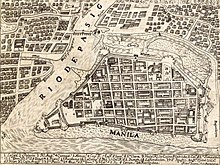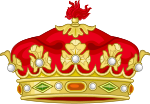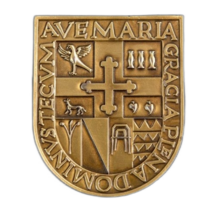|
Fernando Vélaz de Medrano y Bracamonte
Fernando Agustín Vélaz de Medrano y Bracamonte y Dávila (23 December 1742, London, England – 22 November 1791, near the Cape of Good Hope), 4th Marquess of Tabuérniga, 15th Marquess of Cañete, 6th Marquess of Fuente el Sol, 8th Marquess of Navamorcuende, 15th Lord of Montalbo, and a Grandee of Spain, was a Spanish nobleman from the House of Medrano, an aristocrat, military officer, and Knight of the Order of Malta. He is best remembered for his close friendship with the writer José Cadalso. In his military career, Fernando participated in the Seven Years' War at the siege of Almeida in 1762, served as a Spanish Royal Guard, and was the Aide-de-camp to Governor Pedro de Cevallos and Viceroy Juan José de Vértiz, becoming a trusted confidant to both leaders. In 1780, he supported de Vértiz in maintaining Spanish colonial rule in South America during the Tupac Amaru Rebellion. During this time, he corresponded with the Prince of Asturias, the future Charles IV of Spain, informing him of the rebellion and denouncing widespread corruption by royal officials, particularly in their administration of tobacco and playing card monopolies imposed by Minister José de Gálvez. His criticisms led to his exile by Gálvez in 1781 to Manila in the Philippines, where he remained until receiving a royal pardon in 1791. Early yearsFernando Agustín Vélaz de Medrano y Bracamonte y Dávila was born on 23 December 1742 in London, Great Britain.[1] He was the son of Jaime José Ignacio Velaz de Medrano y Barros, 3rd Marquess of Tabuérniga.[2] Fernando was also the grandson of Jaime Vélaz de Medrano y Hurtado de Mendoza, 2nd Marquess of Tabuérniga, and the great-grandson of Antonio Vélaz de Medrano, I Marquess of Tabuérniga, son of Pedro Vélaz de Medrano, 2nd Lord of Tabuérniga.[3] His mother, Petronila de Bracamonte Dávila y Villalón, was the daughter of the Marquesses of Fuente el Sol.[1] Family exile in LondonHe was heavily criticized because of "the infamous accusation of being a heretic for being English."[4] His father Jaime had formed a close relationship with Frederick, Prince of Wales, and King George II of Great Britain, obtaining a pension from both sovereigns during his stay in London, totaling 1,000 pounds.[1] His father had been exiled after escaping from the castle of Vélez-Málaga, where he had been imprisoned by royal decree for conspiring to elevate Fernando VI to the Spanish Crown in 1730.[1] The family’s exile in London lasted until 1748, when King Fernando VI ascended to the throne and granted them a royal pardon.[5] Return to Spain (1748)Returning to Spain in 1748, Fernando spent his early childhood in Ávila, where he was catechized on 2 November 1749 in the Chapel of Our Lady of the Annunciation by the parish priest of Saint Vincent Martyr.[6] His father, the 3rd Marquess of Tabuérniga, died in 1752, at which point he inherited the title, becoming the 4th Marquess of Tabuérniga.[1] Education (1757)His uncle, the Marquess of Fuente el Sol, took charge of his education and secured his admission in 1757 to the prestigious Royal Seminary of Nobles in Madrid. He was educated alongside his "very dear classmate,"[7] the future King Charles IV of Spain. This institution, designed for the sons of noble families, prepared Fernando for a career in the military.[6] Spanish Royal GuardsUpon completing his education at the Royal Seminary of Nobles in Madrid, Fernando Vélaz de Medrano joined the elite Spanish royal guards regiment on 2 March 1762, following in his father’s footsteps.[6] Military career In 1762 he participated in the War of Portugal, part of the Seven Years’ War, specifically in the siege of Almeida, where he blockaded, sieged, and captured Almeida.[6] His promotion to second lieutenant was delayed several times, only materializing on January 8, 1774. In the 1770s, he was sent to the Río de la Plata, and became an aide-de-camp to Pedro Antonio de Cevallos, where he also took part in several military actions, notably the failed defense of Río Grande de San Pedro (1776) and the campaign led by Cevallos and Medrano to reclaim Colonia del Sacramento (1777).[6] José de CadalsoMedrano was a friend of the military official and writer José de Cadalso who in his writings recounts the following anecdote that occurred in the campaign of Portugal:
Tupac Amaru rebellion Settling in Buenos Aires, Fernando Vélaz de Medrano became a trusted confidant and an aide-de-camp of the second viceroy of the Río de la Plata, Juan José de Vértiz. Medrano was involved in quelling the Tupac Amaru Rebellion (1780–1783). The rebellion, led by José Gabriel Condorcanqui, also known as Tupac Amaru II, sought to overthrow Spanish colonial rule in the Andean region. It was one of the largest and most disruptive uprisings against the Spanish Crown in South America during the 18th century, and its ripple effects extended across the viceroyalties, including the Río de la Plata.[6] As an aide-de-camp to Viceroy Juan José de Vértiz, Fernando was privy to the administrative and military response to the rebellion. Though the uprising was centered in the Viceroyalty of Peru, its ramifications prompted viceroys across Spanish America to bolster defenses and address the unrest's potential to spread. Fernando’s contributions were primarily in intelligence and planning. According to contemporary sources, he worked closely with Vértiz to coordinate communications and defensive strategies to prevent the rebellion from gaining traction in the southern viceroyalty. Medrano played a key role in advising Vértiz on the allocation of resources and troops to fortify vulnerable areas, such as the frontier regions and key urban centers like Buenos Aires and Montevideo.[6] Letters to the Prince of AsturiasAdditionally, Fernando is alleged to have been involved in diplomatic intelligence efforts during the rebellion of Tupac Amaru II. According to Jacinto Ventura de Molina, Fernando maintained correspondence with the Prince of Asturias, the future King Charles IV of Spain, in which he reported on the rebellion’s progress and the policies that may have contributed to its escalation. In these reports, Fernando reportedly criticized the tobacco and playing card monopolies imposed by Minister José de Gálvez, which were seen as a catalyst for the unrest. These communications, while intended to inform and influence Spanish policy, ultimately placed Fernando under suspicion of intrigue against Gálvez, leading to his eventual exile by Gálvez.[6] Arrest and exile in the PhilippinesIn 1781, Fernando Vélaz de Medrano was arrested by order of Secretary of War Múzquiz for alleged intrigue in the quarters of the Prince of Asturias, the future King Charles IV.[9] This marked the beginning of a lengthy exile that would define the later years of his life. The reasons for his arrest and subsequent exile have been the subject of historical investigation. According to contemporary testimony from Jacinto Ventura de Molina, Fernando was accused of conspiring against Minister José de Gálvez, one of the most influential figures in the Spanish government.[6] Ventura de Molina recounts:
The specific accusation involved Fernando’s communications with the Prince, in which he reportedly criticized the policies of Gálvez, particularly the tobacco and playing card monopolies, as major contributors to the Tupac Amaru Rebellion. These policies had indeed sparked unrest, but Fernando’s framing of them as the root cause of the rebellion directly challenged Gálvez’s authority. As a result, Fernando was stripped of his duties and sent on an arduous journey of exile. Initially confined in Montevideo, he was later transferred to Lima, Acapulco, and eventually the Philippines.[6] His exile was compounded by severe restrictions, including the prohibition of communication, the use of ink and paper, and any contact with external networks. Despite his eventual pardon by King Charles IV in 1791, his years of exile left an indelible mark on his life and legacy.[6] Life in Manila (1781–1791) Although Fernando’s confinement in Manila was initially intended to be as restrictive as the terms decreed in 1781, the passage of time and geographic distance led to a gradual relaxation of these conditions. According to Jacinto Ventura de Molina, Fernando lived a relatively unconfined life:
Luisa de CuencaFernando was frequently granted permissions to hunt, ride, and live without obligations, except for presenting himself periodically at the fortress as a prisoner. During this period, he formed a relationship with a Tagalog woman, Luisa Cuenca, with whom he had two sons and a daughter. Friar Joaquín Martínez de Zúñiga corroborates this, identifying Luisa as the marquess’s partner.[11] The Cuenca family were among the wealthiest in the town of Bacoor, located near Manila. They were considered “Bacoor’s first family,” tracing their lineage to Lorenzo de Cuenca, who served as gobernadorcillo in 1685–1686.[12] Royal order of 1785During Fernando’s time there, the town was rebuilding its church, which had been destroyed by the British in 1763 due to Bacoor’s strategic location. Despite his exile, Fernando maintained a connection to his noble heritage. A royal order dated June 2, 1785, directed that 30,000 reales de vellón deposited in the Secretariat of the Indies be delivered to the Marquess of Tabuérniga, ensuring his financial stability.[6] Economic contributionsFernando’s relatively free lifestyle allowed him to contribute to the local economy. He assisted the Royal Philippine Company in introducing cotton cultivation in Bacoor and surrounding areas, an important initiative for the company, which also promoted the silk industry in the Philippines. This period of exile, while isolating him from Spain, saw Fernando actively engage in the economic and social life of his host community.[6] Inheritance In the Philippine archipelago, Fernando Augustín Vélaz de Medrano y Bracamonte y Dávila, 4th Marquess of Tabuerniga, received news in 1786 that he had inherited the titles of his maternal uncle, Agustín Domingo de Bracamonte Dávila y Villalón, becoming the 15th Marquess of Cañete (GE) [es],[13] 6th Marquess of Fuente el Sol [es], 8th Marquess of Navamorcuende [es], and 15th Lord of Montalbo. With these new titles, he attained the rank of Grandee of Spain of the second class.[14][15][16] Health issuesThough Fernando’s life in Manila offered relative comfort compared to the harsh terms of his original confinement, the many years of exile took a significant toll on his health. He became “disfigured, pockmarked, and lame from a broken thigh,”[17] physical reminders of his hardships during this period. Health issues had already begun to manifest during his maritime journey to Acapulco, one of the early stages of his exile.[6] At the time, he was examined by Dr. Andrés Montaner y Virgili, a retired naval surgeon major and director of Madrid’s Royal Amphitheater, and Dr. Manuel Antonio Moreno, a senior naval surgeon. Their diagnosis was severe:
By the time he was living in Manila, the Marquess of Tabuérniga's declining physical condition had become increasingly apparent. The severity of his ailments prompted authorities to verify his mental and physical fitness when he inherited his uncle’s titles in 1786. Philippine officials were instructed to confirm whether he was “in good health, with sound memory, understanding, and will.”[6] The confirmation of his survival and competence thwarted the ambitions of rival aristocrats who had hoped to claim his inheritance. Despite becoming the Marquess of Fuente el Sol, Cañete, and Navamorcuende, and attaining the rank of Grandee of Spain of the second class, his new status did little to improve his circumstances. His family made repeated pleas to Prime Minister Floridablanca and King Charles III for his return, including a heartfelt appeal from the Marchioness of Fuente el Sol, but all requests were dismissed.[6] Royal pardonIt was only after the death of Charles III and the ascension of Charles IV that Fernando was finally pardoned in 1791. However, the pardon came with a stipulation: he was forbidden from entering Madrid or any royal sites. His years of exile, compounded by deteriorating health, left him a shadow of his former self, even as his noble status remained intact.[6] DeathFernando’s royal repression, like that of his father, only eased with a change in monarch. After the death of King Charles III, the newly ascended King Charles IV, who had been the prince Fernando once conspired with, granted him a royal pardon in 1791. Unlike his father, however, Fernando was unable to complete his journey home to Spain. The details of his attempted return are preserved in an account by his servant, José Fernández Campoy, addressed to his agent Manuel López Delgado. Initially, Fernando and his entourage sought passage on a ship from the Royal Philippine Company, but ongoing hostilities between Britain and Spain made this impossible. Instead, they boarded a Portuguese vessel in early 1791, which unfortunately ran aground in the Jolo Strait, exposing them to the dangers of hostile Malay natives.[6] Final voyageUpon reaching Madras, Fernando’s health deteriorated significantly. Campoy described his master as “a second Job, slowly recovering as his physical condition declined daily.” Despite his failing health, Fernando and his companions managed to secure passage on an English packet ship called Swallow, believing it would stop in Lisbon, allowing them to complete their journey to Spain overland. On September 20, 1791, they embarked on what would become Fernando’s final voyage. On November 22, 1791, just two months later, Fernando Vélaz de Medrano y Bracamonte y Dávila died near the Cape of Good Hope, never fulfilling his dream of returning to his homeland.[6] FamilyHe left behind two illegitimate children in the Philippines from an extramarital relationship with a Tagalog woman named Luisa Cuenca, a native of Bacoor, whose family belonged to the Filipino nobility known as the Principalía. The first Philippine ambassador to the United Kingdom, José E. Romero, was a direct descendant of Fernando and Luisa.[6][18][19] Jose E. Romero's maternal grandmother Aleja Silva Calumpang was a great-granddaughter of Fernando Vélaz de Medrano y Bracamonte y Dávila. Through his maternal grandmother, Romero was a descendant of Alfonso XI of Castile through four of his sons: Peter of Castile, the twins Henry II of Castile and Fadrique Alfonso, 1st Lord of Haro, and Sancho Alfonso, 1st Count of Albuquerque. Through Peter of Castile's mother Maria of Portugal, he was also a descendant of Afonso IV of Portugal.[20][21][22][23][24] Marquessate of TabuérnigaAfter Fernando's death without legitimate succession, the Marquessate of Tabuérniga passed to his aunt, Andrea Vélaz de Medrano y Ferrari. Jorge Floran de Buseembour (Luxembourg, 1672), Baron of Nonancourt, married Andrea Narcisa Vélaz de Medrano y Ferrari (Cádiz, 1701), V Marchioness of Tabuérniga, who was the aunt of Fernando Vélaz de Medrano and lived as a widow in Miranda de Ebro.[25] Together, the couple had two sons:
Ancestry
See also
References
|
|||||||||||||||||||||||||||||||||||||||||||||||||||||||||||||||||||||||||||||||||||||||||||||||||||||||||||||||||||||||||||||||||||||||||||||||||||||||||||||||||||||||||||||||||||||||||||||||||||||||||||||||||||||||||||||||||||||||||||||||||||||||||||||||||||||||||||||||||||||||||||||||||||||||||||||
Portal di Ensiklopedia Dunia
